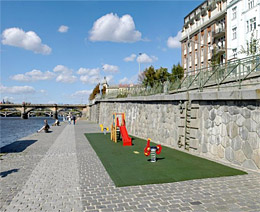
The exhibition documents the transformations of Prague's riverbanks
 |
The exhibition focuses mainly on the banks of the Vltava River from Vyšehrad to the Faculty of Law. People can compare their appearance from 150 years ago with the present state in the photographs.
"We selected from several thousand photographs; the photo archive of the development department has about 50,000 in total. Visitors will see a hundred of the best ones along with several images of graphic works," said the director of the ÚRM, Bořek Votava. "One of the rarest photographs is from 1865, showing the construction of today's Štefánik Bridge. Back then, it was called the František I Bridge," added the exhibition's author, Ladislav Honeiser.
According to the architects, the riverbanks changed the most from the second half of the 19th century, when some new bridges and riverbank walls were constructed. Before the riverbank walls were built, access to the river was via a natural slope, and buildings had to be sufficiently far from the water to avoid being washed away by floods. Only then did attractive areas for construction come up along the water, where some landmarks were built, such as the National Theatre, the Faculty of Law of Charles University, or the Rudolfinum.
A separate chapter of the exhibition is dedicated to mills and wood storage, which the riverbanks served for a long time. The Vltava was, at the time when railways did not exist, almost the only means of transporting larger quantities of wood. On the rivers, the so-called čapadla were established, arch-like passages in the riverbank walls, which were used to catch and pull up the wood. People can still see čapadla today on Smetana and Rašín Riverbanks.
"The mystery of today is how our ancestors managed to stack wood on top of each other to a height of seven meters without any external support. Therefore, we invite visitors to record their opinions and explanations in the exhibition book,” noted Honeiser.
The exhibition titled Transformations of the City - Old Town and New Town Bank is open on the fourth floor in the architects' hall from Tuesday to Friday from 9:00 AM to 6:00 PM, and on Mondays from 11:00 AM to 6:00 PM. It is accessible for free.
The English translation is powered by AI tool. Switch to Czech to view the original text source.
0 comments
add comment












